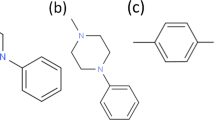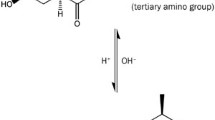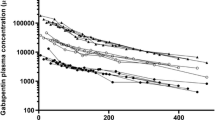Abstract
Purpose. Previous in situ and in vitro studies indicated that the intestinal absorption of enalapril is a saturable carrier-mediated process via the dipeptide transporter system (DTS); however, the oral absorption of enalapril has not been reported to be a saturable process in vivo. Our objectives were to: 1) evaluate the suitability of enalapril as a probe of the DTS, and 2) compare various experimental models as they pertain to studying the DTS.
Methods. The in vitro uptake of enalapril by rat intestinal rings and permeability across Caco-2 cells were studied as a function of concentration and in the presence of compounds that are known substrates of the DTS. The effect of enalapril on the uptake of [3H]-glycyl-L-proline (gly-L-pro) by Caco-2 cells was also examined. In vivo studies were conducted in rats (1 to 50 mg/kg) and dogs (0.06 to 6 mg/kg) to evaluate the oral absorption of enalapril over a wide dose range.
Results. In vitro intestinal uptake/permeability of enalapril was not saturable nor inhibited by p-lactam antibiotics, gly-L-pro, or SQ-29852. Moreover, a 20,000-fold molar excess of enalapril did not inhibit the uptake of [3H]-gly-L-pro by Caco-2 cells. The in vivo studies in rats and dogs did not demonstrate saturable absorption.
Conclusions. The present in vitro and in vivo results indicated that enalapril is primarily absorbed by a non-saturable, passive diffusion process and it is not a suitable model compound for studying the DTS.
Similar content being viewed by others
REFERENCES
D. I. Friedman and G. L. Amidon. Passive and carrier-mediated intestinal absorption components of two angiotensin converting enzyme (ACE) inhibitor prodrugs in rats: enalapril and fosinopril. Pharm. Res. 6:1043–1047 (1989).
H. Yuasa, G. L. Amidon, and D. Fleisher. Noncompetitive inhibition of intestinal cephradine uptake by enalapril: An enalapril specific inhibitory binding site on the peptide carrier, Pharm. Res. 8:(10), S-221 (1991).
S. Yee, and G. L. Amidon. Transport characterization of the ACE inhibitor enalapril in rabbit intestinal brush border membrane vesicles, Pharm. Res. 8:(10), S-198 (1991).
D. T. Thwaites, M. Cavet, B. H. Hirst, and N. Simmons. Angiotensin-converting enzyme (ACE) inhibitor transport in human intestinal epithelial (Caco-2) cells, Brit. J. Pharmacol. 114:981–986 (1995).
A. M. Marino, S. Chong, S. A. Dando, K. J. Kripalani, M. S. Bathala, and R. A. Morrison. Distribution of the dipeptide transporter system along the gastrointestinal tract of rats based on absorption of a stable and specific probe, SQ-29852, J. Pharm. Sci. 85:282–286 (1996).
V. A. Moore, S. Chong, S. A. Dando, W. Lau, W. J. Irwin, P. Timmins, and R. A. Morrison. Systematic evaluation of the structural requirements for the intestinal dipeptide transporter system, Pharm. Res. 12:(9) (suppl), S-301 (1995).
A. H. Dantzig and L. Bergin. Uptake of the cephalosporin, cephalexin, by a dipeptide transport carrier in the human intestinal cell line, Caco-2, Biochemica et Biophysica Acta 1027:211–217 (1990).
A. H. Dantzig, D. C. Duckworth, and L. B. Tabas. Transport mechanism responsible for the absorption of loracarbef, cefixime, and cefuroxime axetil into human intestinal Caco-2 cells, Biochim. Biophys. Acta. 1191:7–13 (1994).
D. I. Friedman and G. L. Amidon, Intestinal absorption mechanism of dipeptide angiotensin converting enzyme inhibitors of the lysyl-proline type: lisinopril and SQ 29,852, J. Pharm. Sci. 78:995–998 (1989).
M. Hu, J. Chen, Y. Zhu, A. H. Dantzig, R. E. Stratford, and M. T. Kuhfeld. Mechanism and kinetics of transcellular transport of a new beta-lactam antibiotic across an intestinal epithelial membrane model system (Caco-2), Pharm. Res. 11:(10), 1405–13 (1994).
P. L. Nicklin, W. J. Irwin, and P. Timmins. Uptake and transport of an ACE-inhibitor (SQ-29852) by Caco-2 cells, J. Pharm. Pharmacol. 44:1091 (1992).
M. S. Bathala, S. J. Lan, A. V. Dean, K. J. Kripalani, and S. H. Weinstein. Disposition of SQ-29852 in dogs, Pharm. Res. 6:(suppl.) S-282, (1989).
L. Moore, P. Kramer, J. Foley, J. Tu, B. Swanson, and K. Duchin. Ascending multiple-dose study of a new ACE inhibitor, Abstract presented at the ASCPT meeting, San Diego, CA, March 9–11, 1989.
M. Sugawara, H. Saitoh, K. Iseki, K. Miyazaki, and T. Arita. Contribution of passive and transport mechanisms to the intestinal absorption of β-lactam antibiotics, J. Pharm. Pharmacol. 42:314–318 (1989).
B. H. Stewart, S. A. Dando, and R. A. Morrison. In vitro uptake of SQ-29852 by everted rat intestinal rings, Pharm. Res. 7:(9) (suppl), S-156 (1990).
S. Chong, S. A. Dando, and R. A. Morrison. In vitro permeability through Caco-2 cells is not quantitatively predictive of in vivo absorption for drugs absorbed via the dipeptide transporter system, Pharm. Res. 13:(1), (1996).
K. Tamura, P. K. Bhatnagar, J. S. Takata, C.-P. Lee, P. L. Smith, and R. T. Borchardt. Inhibition of uptake by the oligopeptide transporter does not correlate with transepithelial transport, Pharm. Res. 12:(9) (suppl), S-302 (1995).
Author information
Authors and Affiliations
Rights and permissions
About this article
Cite this article
Morrison, R.A., Chong, S., Marino, A.M. et al. Suitability of Enalapril as a Probe of the Dipeptide Transporter System: In Vitro and In Vivo Studies. Pharm Res 13, 1078–1082 (1996). https://doi.org/10.1023/A:1016071027177
Issue Date:
DOI: https://doi.org/10.1023/A:1016071027177




